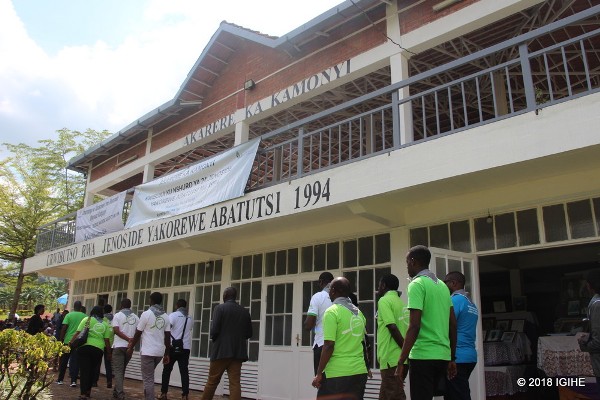
By BIZIMANA Jean Damascène*
On April 28, 1994, the criminal government continued to implement its plan to exterminate Tutsi. This document shows some locations where Tutsi were killed on this day.
1. Oxfam denounced genocide against the Tutsi in Rwanda
On April 28, 1994, US Secretary of State for Africa Prudence Bushnell called Théoneste Bagosora and told him to stop the killing that he was leading together with his criminal government. This warning was like wasting her time because the massacre continued and the same day in Paris, France, Jérôme Bicamumpaka, the former Minister of Foreign Affairs in the criminal government held a press conference, furthering the lies of the government he represented, saying that there were no killings, and that the figures of more than 100,000 were false.Bagosora informed high ranking military that they should focus more on diplomacy, so that the massacre of Tutsi cannot be identified, and that they would find a way to get rid of it.
However, on April 28, 1994, OXFAM issued a statement condemning the Genocide against the Tutsi in Rwanda.
2. Tutsi massacre at Kizenga hill, Rwamatamu at the lake Kivu, Kibuye
Kizenga is a high hill with dense forest, in 1994 Tutsi of the former Rwamatamu Commune (Gihombo and Mahembe Sectors) had gathered and fled to the hill. It was On April 28, 1994 that an attack led by Obed Ruzindana and Interahamwe from Mugonero, along with Interahamwe of Yusuf called by Ruzindana and extremist Hutu of Mugonero, climbed up to the hill and killed them with guns and grenades. Those who survived headed to in Mugonero. Arriving there, they found that all the boats were hidden, and were also killed.
3. Tutsi massacre at ISAR Songa, Huye
Interahamwe and Hutu from Maraba and Kinyamakara started to attack by crossing Mwogo and they had plans with some Hutu from Ruhashya and Rusatira. People came together regardless of ethnicity and went to fight them but it was in vain because one day they came in large numbers with soldiers and guns. Many Tutsi fled and camped on Rubaba and Sazange hills waiting for the way forward. Next day, around nine o’clock in the morning, the attackers started from Rwaniro and Kibika, others went up to Gashoba and Kiboga looting, burning and killing the Tutsi everywhere they passed.
Tutsi who had taken refuge on Rubaba hill including Rusagara Francois and George (clothe sellers), Sinzi Tharcisse and his older brother Butare Frederic sons of Gakwisi, Gatera and many others had decided to go and fight the killers. They divided themselves into two groups, one group containing Rushogoro Francois, who confronted the killers, had passed through Kiboga and the other group passed at Gashoba and descended towards the valley.
When they arrived at Rubayiza’s house, they chased away killers who were looting and burning houses and sent them towards the valley. Near the valley, they met other killers who had already been defeated in Kiboga and the latter shot at them towards Rubaba. On their way back they realised that Hutu houses had been marked with banana leaves, ropes, so that they would not be neither looted nor burned. On April 24, 1994, some Tutsi passed through Songa towards Mayaga and spent the night in Gatugunguru where local residents took away their cows.
The soldiers and gendarms of Nyanza sent by François-Xavier Birikunzira, gathered all Tutsi in Songa and told them that if they did not go there they would eat their cows.
More than 40,000 Tutsi were killed in ISAR Songa. About 7,000 were on the top of the hill, while children and women were at the bottom of the hill at a place called Munyinya wa Songa.
Every hour, the attacks would come, Sinzi Tharcisse would position all the young men on the borders of the camp to fight and would defeat them. The killers had brought guns but as they shot, Tutsi young men crawled down and caught them on spot. When the killers got defeated, they called for support from Nyanza Gendarmery.
The attack of 28 April, 1994 contained more than 60 gendarmes with heavy guns such as machine guns and lance roquettes and they killed them all. The attackers came in line and surrounded the camp and threw strims amongst them. The attackers came as if they had come to fight against powerful army because they had learnt that these particular Tutsi were very strong as they had retaliated many attacks from many places.
On the other hand, there were a large number of people armed with traditional weapons who have formed vertical lines. Due to the heavy noise of the bullets that they were not familiar with, they were not able to flee and hence many were shot dead others were chopped by interahamwe. Others were killed gradually as they marched and run for their lives hoping to flee to Burundi. Most of them were killed in Gakoma where they used to call “kwa Kantano” (RTLM journalist), while others were confronted in Ramba, Muyanga commune. About 108 people were able to cross to Burundi.
The Tutsi who were gathered in Songa had fled from all around: Gikongoro (Kinyamakara, Rukondo), Nyanza, Ruhashya, Rusatira, Ntyazo and Muyira.
Conclusion
Massacre of Tutsi continued. This was done in a way that every so-called Tutsi would be killed, most of whom were killed while fleeing. On this day many were killed within administrative buildings, communes, churches because people falsely believed that they could survive in such places. (End).
* BIZIMANA Jean Damascène, Executive Secretary National Commission for the Fight Against Genocide (CNLG)
